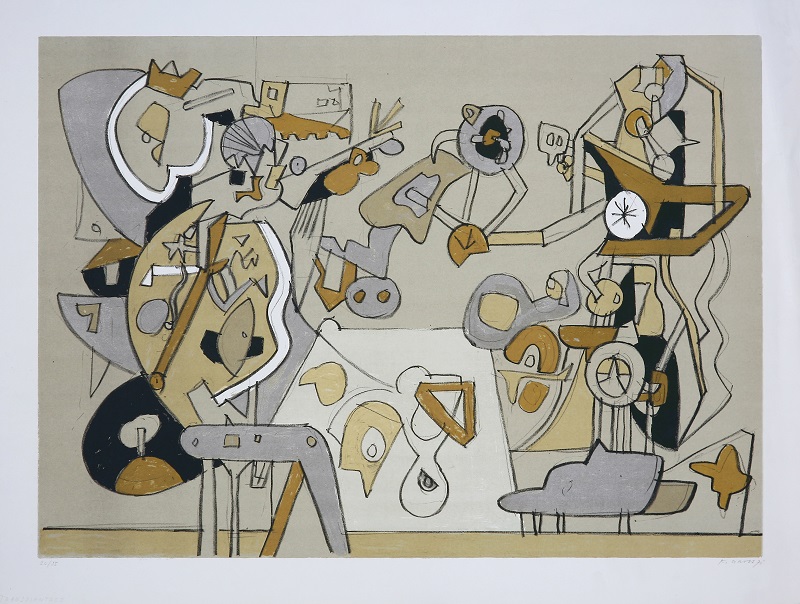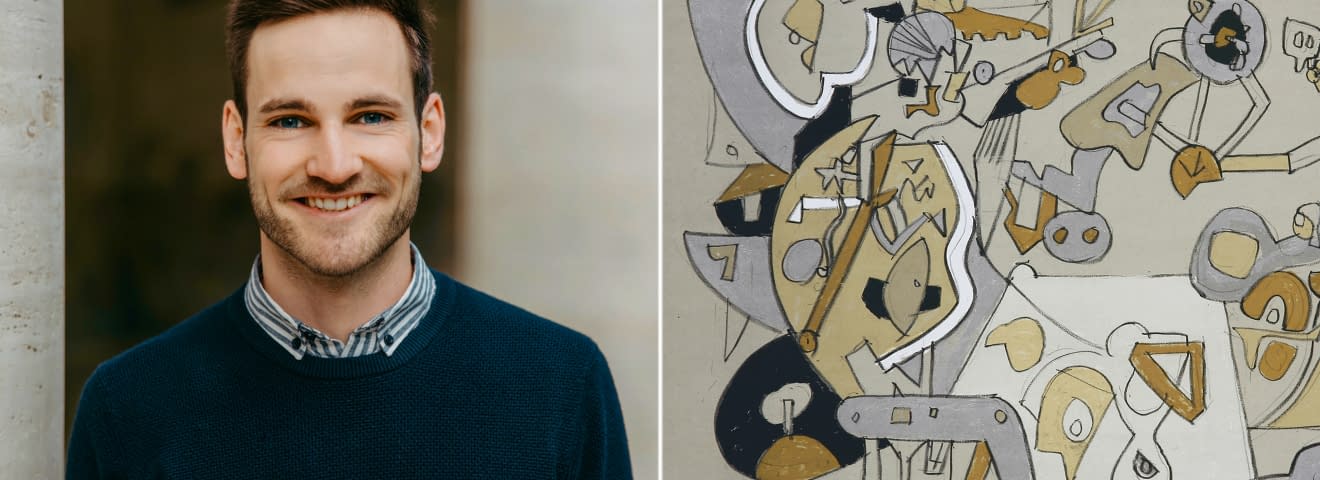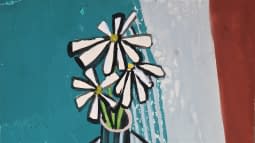Crossover # 1 What Does Art Have to Do with Medicine? Thoughts on Medicine and Art by Doctor of Medicine Sandro
In the centre of the picture “Transplantage” (engl. Transplantation) we find a white surface, which is the only element that gives the artwork a spatial dimension. The title of the work suggests that this could be an operating table. Only a few objects lie on it. Compared to its surroundings, the table appears tidy. The white colour makes it stand out and creates the idea of it being clean to the point of sterility. It is difficult to see what exactly is lying on the table. Do we see an eye? A body? Or only parts of it?
Around the table are various figures that seem to be connected to each other. This creates the impression of a chain of elements, similar to a conveyor belt. In some places, the individual elements touch the white table; presumably, parts of these mechanical-looking figures also extend over the table. A lot can only be assumed, since surfaces or shadows that would give the figures a three-dimensionality are missing. The elements appear flat and bodiless. So whether they are actually actual figures can be questioned. Nevertheless - and surprisingly with a minimum of information - the idea of an operating machine is created.
The machine seems complex and its functions incomprehensible. We can only guess about the processes taking place at that moment and their goal. Perhaps a donor organ is being removed, perhaps someone is receiving the organ that will save them... The classic inventory of an operating theatre with ventilator, monitors and surgical instruments cannot be clearly identified in the picture. On the left side, anaesthesia and ventilation could be carried out, a line leading to the table perhaps symbolises a ventilation or infusion tube. Here and there one recognises buttons and switches, wheels and hinges. But the viewer is left with the impression that this representation has little in common with his or her idea of an operating theatre.
Transplantation is depicted as a complex and opaque process that is carried out by an independently acting machine.

The artwork, which was created in 1971, picks up on the progress that was made in transplant medicine in the 20th century. Almost 70 years ago, the first successful kidney transplant was performed on a person. Although skin transplants had been performed before, this development heralded a new era in medicine, as it could extend the life expectancy of patients with terminal kidney failure by decades.
Of course, this milestone was revolutionary in its time. However, it was only one of many developments taking place at the same time in the so-called golden age of medicine (first half of the 20th century). From this point of view, it must have been obvious to the artist that further developments would soon follow. The artist has taken up these advances in his work and thought them further in his version of the future. He presents the viewer with a futuristic scenario in which operating machines have taken over the work of surgeons.
Indeed, robots are surpassing the skills of experienced surgeons in certain areas. One example is the use of robots in minimally invasive surgery. In such procedures, they achieve higher precision than humans and show no signs of fatigue. We can now ask ourselves: Why do we need surgeons when a machine could perform the same procedure more safely and efficiently? These are highly relevant questions for the self-image of surgeons.
Robots have been part of everyday life in the operating theatre for some time now. However, the current state of development of the technology is still far from making autonomously performed interventions possible. One reason for this is that it has not yet been possible to imitate the unique combination of dexterity, strength and fine motor skills of the human hand. And although intelligent systems could perform standardised procedures, they lack the skills to recognise and solve unforeseen problems, which is crucial for the safety and success of a procedure. Finally, there remains the unresolved issue of legal liability when errors occur. For these reasons, it is unlikely that robots will move beyond the role of an assistant in the foreseeable future.
František Gross may also want to show viewers the interaction between humans and machines with his artwork. Faces or human forms can be recognised in various parts of the machine-like figures, giving the impression that human and machine are at work here at the same time.
The interweaving of both entities could indicate that they are working together. Such collaboration between humankind and machines has been responsible for many successes in medicine. Examples include the DaVinci high-precision robot, which gives surgeons finer control over instruments, and the anaesthesia ventilator, which can be used to programme ventilation for intubated patients.
On the one hand, machines depend on our programming, maintenance and repair to function. On the other hand, we depend on the support of machines because they can do many tasks more precisely or faster. So it takes both sides, because neither humans nor machines act independently of each other. Overall, the success of an intervention depends much less on humans or machines alone and much more on the effective cooperation between humans and machines. The question is not whether the future of surgeons is threatened by technology, but rather how these synergies between humans and machines can be optimally used and expanded in order to achieve progress in the future.
In this work, the artist may have symbolically represented not only the coexistence of humankind and machine, but also the prevailing mechanistic view of the world. According to this approach, the human being is regarded as a complex machine in which all processes can be explained as the result of a cause-and-effect principle.
Initially, the successes of transplant medicine raised hopes of immortality. The idea was to replace defective or old parts of the human machine with new ones and thus restore the functionality of organs or organ systems. However, it soon became apparent that our scientific models for understanding nature are often too simplistic and short-sighted.
Because in many cases, transplanted organs are recognised as foreign by the recipient's immune system and are rejected. In order to solve the problem of rejection, recipients have to take permanent medication that suppresses the immune system. However, these often have side effects, such as an increased susceptibility to infections. So obviously, a successful organ donation requires more than just the transplantation of an anatomical structure.
The mechanistic worldview now seems to have had its day. Perhaps it is time to adopt a new, more systemic worldview?
Closing Thoughts
The aspects in František Gross' painting open up important questions about the coexistence of man and machine and are thus highly relevant for our time. Technologisation has not stopped at medicine. Machines and applications based on artificial intelligence are taking over more and more work that used to be done by medical staff. It is difficult to predict the future development of technologisation, as forecasts based on a reductionist view of the world are unreliable.
Medical science has made enormous progress since 1971. The proper use of technology in medicine will certainly continue to occupy us for another 50 years.
Note: Do you work in a certain profession or industry and are interested in art? Choose a suitable work of art and let us know what it has to do with your profession. What thoughts does it trigger in you through the lens of your profession? Contact us via our email hello@art24.world. We look forward to hearing from you.
Image credits:
Image: Transplantation, František Gross, 1971, Lithograph, photo: art24.
Glossary:
Mechanistic worldview: A philosophical position that states that only matter exists and thus the human mind/will cannot be explained. "Term for causal and effect-causal explanation of circumstances and events by physical-chemical and materialistic-energetic laws via ultimate, in themselves unchanging particles." (Metzler Lexikon Philosophie)
Reductionist: A philosophical or scientific doctrine according to which a system is determined by its individual components. Through this reduced view of the individual elements, the interconnections of the entire system are not taken into account.




